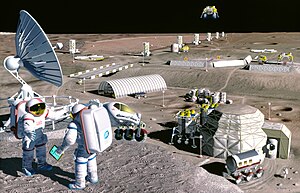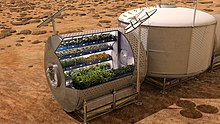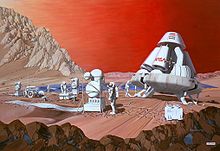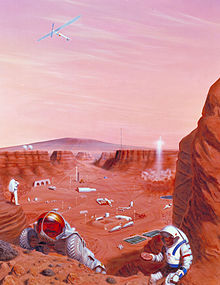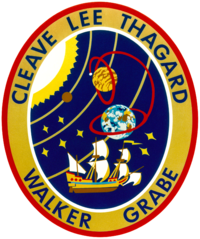From Wikipedia, the free encyclopedia
Depiction of
NASA's plans to grow food on
Mars
Space colonization (also called space settlement or extraterrestrial colonization) is the hypothetical permanent habitation and exploitation of natural resources from outside planet Earth. As such it is a form of human presence in space, beyond human spaceflight or operating space outposts.
Many arguments have been made for and against space colonization. The two most common in favor of colonization are survival of human civilization and the biosphere in the event of a planetary-scale disaster (natural or human-made),
and the availability of additional resources in space that could enable
expansion of human society. The most common objections to colonization
include concerns that the commodification
of the cosmos may be likely to enhance the interests of the already
powerful, including major economic and military institutions, and to
exacerbate pre-existing detrimental processes such as wars, economic inequality, and environmental degradation.
No space colonies have been built so far. Currently, the building
of a space colony would present a set of huge technological and
economic challenges. Space settlements would have to provide for nearly
all (or all) the material needs of hundreds or thousands of humans, in
an environment out in space that is very hostile to human life. They would involve technologies, such as controlled ecological life-support systems,
that have yet to be developed in any meaningful way. They would also
have to deal with the as-yet unknown issue of how humans would behave
and thrive in such places long-term. Because of the present cost of
sending anything from the surface of the Earth into orbit (around $1400
per kg, or $640 per-pound, to low Earth orbit by Falcon Heavy), a space colony would currently be a massively expensive project.
There are yet no plans for building space colonies by any
large-scale organization, either government or private. However, many
proposals, speculations, and designs for space settlements have been
made through the years, and a considerable number of space colonization advocates and groups are active. Several famous scientists, such as Freeman Dyson, have come out in favor of space settlement.
On the technological front, there is ongoing progress in making access to space cheaper (reusable launch systems could reach $20 per kg to orbit), and in creating automated manufacturing and construction techniques.
Definition
The term is sometimes applied to any permanent human presence, even robotic, but particularly, along with the term "settlement", it is applied to any permanent human space habitat, from research stations to self-sustaining communities.
The word colony and colonization are terms rooted in colonial history on Earth, making it a human geographic as well as particularly a political term.
This broad use for any permanent human activity and development in space has been criticized, particularly as colonialist and undifferentiated.
Reasons
Survival of human civilization
The primary argument calling for space colonization is the long-term survival of human civilization and terrestrial life. By developing alternative locations off Earth, the planet's species, including humans, could live on in the event of natural or human-made disasters on our own planet.
On two occasions, theoretical physicist and cosmologist Stephen Hawking
argued for space colonization as a means of saving humanity. In 2001,
Hawking predicted that the human race would become extinct within the
next thousand years, unless colonies could be established in space.
In 2010, he stated that humanity faces two options: either we colonize
space within the next two hundred years, or we will face the long-term
prospect of extinction.
In 2005, then NASA Administrator Michael Griffin identified space colonization as the ultimate goal of current spaceflight programs, saying:
... the goal isn't just scientific
exploration ... it's also about extending the range of human habitat out
from Earth into the solar system as we go forward in time ... In the
long run a single-planet species will not survive ... If we humans want
to survive for hundreds of thousands of millions of years, we must
ultimately populate other planets. Now, today the technology is such
that this is barely conceivable. We're in the infancy of it. ... I'm
talking about that one day, I don't know when that day is, but there
will be more human beings who live off the Earth than on it. We may well
have people living on the Moon. We may have people living on the moons
of Jupiter and other planets. We may have people making habitats on
asteroids ... I know that humans will colonize the solar system and one
day go beyond.
Louis J. Halle, formerly of the United States Department of State, wrote in Foreign Affairs (Summer 1980) that the colonization of space will protect humanity in the event of global nuclear warfare. The physicist Paul Davies
also supports the view that if a planetary catastrophe threatens the
survival of the human species on Earth, a self-sufficient colony could
"reverse-colonize" Earth and restore human civilization. The author and journalist William E. Burrows and the biochemist Robert Shapiro proposed a private project, the Alliance to Rescue Civilization, with the goal of establishing an off-Earth "backup" of human civilization.
Based on his Copernican principle, J. Richard Gott
has estimated that the human race could survive for another 7.8 million
years, but it is not likely to ever colonize other planets. However, he
expressed a hope to be proven wrong, because "colonizing other worlds
is our best chance to hedge our bets and improve the survival prospects
of our species".
In a theoretical study from 2019, a group of researchers have pondered the long-term trajectory of human civilization. It is argued that due to Earth's finitude as well as the limited duration of the Solar System, mankind's survival into the far future will very likely require extensive space colonization. This 'astronomical trajectory' of mankind, as it is termed, could come
about in four steps: First step, plenty of space colonies could be
established at various habitable locations — be it in outer space or on celestial bodies
away from planet earth — and allowed to remain dependent on support
from earth for a start. Second step, these colonies could gradually
become self-sufficient, enabling them to survive if or when the mother
civilization on earth fails or dies. Third step, the colonies could
develop and expand their habitation by themselves on their space stations or celestial bodies, for example via terraforming.
Fourth step, the colonies could self-replicate and establish new
colonies further into space, a process that could then repeat itself and
continue at an exponential rate
throughout cosmos. However, this astronomical trajectory may not be a
lasting one, as it will most likely be interrupted and eventually
decline due to resource depletion or straining competition between
various human factions, bringing about some 'star wars' scenario. In the very far future, mankind is expected to become extinct in any case, as no civilization — whether human or alien — will ever outlive the limited duration of cosmos itself.
Vast resources in space
Resources in space, both in materials and energy, are enormous. The Solar System
alone has, according to different estimates, enough material and energy
to support anywhere from several thousand to over a billion times that
of the current Earth-based human population, mostly from the Sun itself. Outside the Solar System, several hundred billion other planets in the Milky Way
alone provide opportunities for both colonization and resource
collection, though travel to any of them is impossible on any practical
time-scale without interstellar travel by use of generation ships or revolutionary new methods of travel, such as faster-than-light (FTL).
Asteroid mining will also be a key player in space colonization.
Water and materials to make structures and shielding can be easily found
in asteroids. Instead of resupplying on Earth, mining and fuel stations
need to be established on asteroids to facilitate better space travel.
Optical mining is the term NASA uses to describe extracting materials
from asteroids. NASA believes by using propellant derived from asteroids
for exploration to the moon, Mars, and beyond will save $100 billion.
If funding and technology come sooner than estimated, asteroid mining
might be possible within a decade.
All these planets and other bodies offer a virtually endless
supply of resources providing limitless growth potential. Harnessing
these resources can lead to much economic development.
Expansion with fewer negative consequences
Expansion of humans and technological progress has usually resulted
in some form of environmental devastation, and destruction of ecosystems and their accompanying wildlife. In the past, expansion has often come at the expense of displacing many indigenous peoples,
the resulting treatment of these peoples ranging anywhere from
encroachment to genocide. Because space has no known life, this need not
be a consequence, as some space settlement advocates have pointed out.
Counterarguments state that changing only the location but not
the logic of exploitation will not create a more sustainable future.
Alleviating overpopulation and resource demand
Another argument for space colonization is to mitigate the negative effects of overpopulation.
If the resources of space were opened to use and viable life-supporting
habitats were built, Earth would no longer define the limitations of
growth. Although many of Earth's resources are non-renewable, off-planet
colonies could satisfy the majority of the planet's resource
requirements. With the availability of extraterrestrial resources,
demand on terrestrial ones would decline.
Many science fiction authors, including Carl Sagan, Arthur C. Clarke, and Isaac Asimov,
have argued that shipping any excess population into space is not a
viable solution to human overpopulation. According to Clarke, "the
population battle must be fought or won here on Earth". The problem for these authors is not the lack of resources in space (as shown in books such as Mining the Sky), but the physical impracticality of shipping vast numbers of people into space to "solve" overpopulation on Earth.
Other arguments
Advocates
for space colonization cite a presumed innate human drive to explore
and discover, and call it a quality at the core of progress and thriving
civilizations.
Nick Bostrom has argued that from a utilitarian
perspective, space colonization should be a chief goal as it would
enable a very large population to live for a very long period of time
(possibly billions of years), which would produce an enormous amount of
utility (or happiness).
He claims that it is more important to reduce existential risks to
increase the probability of eventual colonization than to accelerate
technological development so that space colonization could happen
sooner. In his paper, he assumes that the created lives will have
positive ethical value despite the problem of suffering.
In a 2001 interview with Freeman Dyson, J. Richard Gott and Sid
Goldstein, they were asked for reasons why some humans should live in
space. Their answers were:
Biotic ethics
is a branch of ethics that values life itself. For biotic ethics, and
their extension to space as panbiotic ethics, it is a human purpose to
secure and propagate life and to use space to maximize life.
Pursuance
Although
some items of the infrastructure requirements above can already be
easily produced on Earth and would therefore not be very valuable as
trade items (oxygen, water, base metal ores, silicates, etc.), other
high value items are more abundant, more easily produced, of higher
quality, or can only be produced in space. These would provide (over the
long-term) a very high return on the initial investment in space
infrastructure.
Some of these high-value trade goods include precious metals, gemstones, power, solar cells, ball bearings, semi-conductors, and pharmaceuticals.
The mining and extraction of metals from a small asteroid the size of 3554 Amun or (6178) 1986 DA,
both small near-Earth asteroids, would be 30 times as much metal as
humans have mined throughout history. A metal asteroid this size would
be worth approximately US$20 trillion at 2001 market prices
Space colonization is seen as a long-term goal of some national space programs.
Since the advent of the 21st-century commercialization of space, which
saw greater cooperation between NASA and the private sector, several
private companies have announced plans toward the colonization of Mars. Among entrepreneurs leading the call for space colonization are Elon Musk, Dennis Tito and Bas Lansdorp.
The main impediments to commercial exploitation of these resources are the very high cost of initial investment, the very long period required for the expected return on those investments (The Eros Project plans a 50-year development), and the fact that the venture has never been carried out before—the high-risk nature of the investment.
Major governments and well-funded corporations have announced
plans for new categories of activities: space tourism and hotels,
prototype space-based solar-power satellites, heavy-lift boosters and asteroid mining—that create needs and capabilities for humans to be present in space.
Method
Building colonies in space would require access to water, food, space, people, construction materials, energy, transportation, communications, life support, simulated gravity, radiation
protection and capital investment. It is likely the colonies would be
located near the necessary physical resources. The practice of space architecture
seeks to transform spaceflight from a heroic test of human endurance to
a normality within the bounds of comfortable experience. As is true of
other frontier-opening endeavors, the capital investment necessary for
space colonization would probably come from governments, an argument made by John Hickman and Neil deGrasse Tyson.
Materials
Colonies on the Moon, Mars, asteroids, or the metal rich planet Mercury, could extract local materials. The Moon is deficient in volatiles such as argon, helium and compounds of carbon, hydrogen and nitrogen.
The LCROSS impacter was targeted at the Cabeus crater which was chosen
as having a high concentration of water for the Moon. A plume of
material erupted in which some water was detected. Mission chief
scientist Anthony Colaprete estimated that the Cabeus crater contains
material with 1% water or possibly more. Water ice
should also be in other permanently shadowed craters near the lunar
poles. Although helium is present only in low concentrations on the
Moon, where it is deposited into regolith by the solar wind, an estimated million tons of He-3 exists over all. It also has industrially significant oxygen, silicon, and metals such as iron, aluminum, and titanium.
Launching materials from Earth is expensive, so bulk materials for colonies could come from the Moon, a near-Earth object (NEO), Phobos, or Deimos. The benefits of using such sources include: a lower gravitational force, no atmospheric drag
on cargo vessels, and no biosphere to damage. Many NEOs contain
substantial amounts of metals. Underneath a drier outer crust (much like
oil shale), some other NEOs are inactive comets which include billions of tons of water ice and kerogen hydrocarbons, as well as some nitrogen compounds.
Farther out, Jupiter's Trojan asteroids are thought to be rich in water ice and other volatiles.
Recycling of some raw materials would almost certainly be necessary.
Energy
Solar energy
in orbit is abundant, reliable, and is commonly used to power
satellites today. There is no night in free space, and no clouds or
atmosphere to block sunlight. Light intensity obeys an inverse-square law. So the solar energy available at distance d from the Sun is E = 1367/d2 W/m2, where d is measured in astronomical units (AU) and 1367 watts/m2 is the energy available at the distance of Earth's orbit from the Sun, 1 AU.
In the weightlessness and vacuum of space, high temperatures for industrial processes can easily be achieved in solar ovens
with huge parabolic reflectors made of metallic foil with very
lightweight support structures. Flat mirrors to reflect sunlight around
radiation shields into living areas (to avoid line-of-sight access for
cosmic rays, or to make the Sun's image appear to move across their
"sky") or onto crops are even lighter and easier to build.
Large solar power photovoltaic cell arrays or thermal power
plants would be needed to meet the electrical power needs of the
settlers' use. In developed parts of Earth, electrical consumption can
average 1 kilowatt/person (or roughly 10 megawatt-hours per person per year.)
These power plants could be at a short distance from the main
structures if wires are used to transmit the power, or much farther away
with wireless power transmission.
A major export of the initial space settlement designs was anticipated to be large solar power satellites (SPS) that would use wireless power transmission (phase-locked microwave
beams or lasers emitting wavelengths that special solar cells convert
with high efficiency) to send power to locations on Earth, or to
colonies on the Moon or other locations in space. For locations on
Earth, this method of getting power is extremely benign, with zero
emissions and far less ground area required per watt than for
conventional solar panels. Once these satellites are primarily built
from lunar or asteroid-derived materials, the price of SPS electricity
could be lower than energy from fossil fuel or nuclear energy; replacing
these would have significant benefits such as the elimination of greenhouse gases and nuclear waste from electricity generation.
Transmitting solar energy wirelessly from the Earth to the Moon
and back is also an idea proposed for the benefit of space colonization
and energy resources. Physicist Dr. David Criswell, who worked for NASA
during the Apollo missions, came up with the idea of using power beams
to transfer energy from space. These beams, microwaves with a wavelength
of about 12 cm, will be almost untouched as they travel through the
atmosphere. They can also be aimed at more industrial areas to keep away
from humans or animal activities. This will allow for safer and more reliable methods of transferring solar energy.
In 2008, scientists were able to send a 20 watt microwave signal from a mountain in Maui to the island of Hawaii. Since then JAXA
and Mitsubishi has teamed up on a $21 billion project in order to place
satellites in orbit which could generate up to 1 gigawatt of energy.
These are the next advancements being done today in order to make
energy be transmitted wirelessly for space-based solar energy.
However, the value of SPS power delivered wirelessly to other
locations in space will typically be far higher than to Earth.
Otherwise, the means of generating the power would need to be included
with these projects and pay the heavy penalty of Earth launch costs.
Therefore, other than proposed demonstration projects for power
delivered to Earth,
the first priority for SPS electricity is likely to be locations in
space, such as communications satellites, fuel depots or "orbital
tugboat" boosters transferring cargo and passengers between low Earth orbit (LEO) and other orbits such as geosynchronous orbit (GEO), lunar orbit or highly-eccentric Earth orbit (HEEO). The system will also rely on satellites and receiving stations on Earth
to convert the energy into electricity. Because of this energy can be
transmitted easily from dayside to nightside meaning power is reliable
24/7.
Nuclear power
is sometimes proposed for colonies located on the Moon or on Mars, as
the supply of solar energy is too discontinuous in these locations; the
Moon has nights of two Earth weeks in duration. Mars has nights,
relatively high gravity, and an atmosphere featuring large dust storms to cover and degrade solar panels. Also, Mars' greater distance from the Sun (1.52 astronomical units, AU) means that only 1/1.522 or about 43% of the solar energy is available at Mars compared with Earth orbit.
Another method would be transmitting energy wirelessly to the lunar or
Martian colonies from solar power satellites (SPSs) as described above;
the difficulties of generating power in these locations make the
relative advantages of SPSs much greater there than for power beamed to
locations on Earth. In order to also be able to fulfill the requirements
of a Moon base and energy to supply life support, maintenance,
communications, and research, a combination of both nuclear and solar
energy will be used in the first colonies.
For both solar thermal and nuclear power generation in airless
environments, such as the Moon and space, and to a lesser extent the
very thin Martian atmosphere, one of the main difficulties is dispersing
the inevitable heat generated. This requires fairly large radiator areas.
Life support
In space settlements, a life support system must recycle or import
all the nutrients without "crashing." The closest terrestrial analogue
to space life support is possibly that of a nuclear submarine.
Nuclear submarines use mechanical life support systems to support
humans for months without surfacing, and this same basic technology
could presumably be employed for space use. However, nuclear submarines
run "open loop"—extracting oxygen from seawater, and typically dumping carbon dioxide overboard, although they recycle existing oxygen. Another commonly proposed life-support system is a closed ecological system such as Biosphere 2.
Radiation protection
Cosmic rays and solar flares create a lethal radiation environment in space. In Earth orbit, the Van Allen belts
make living above the Earth's atmosphere difficult. To protect life,
settlements must be surrounded by sufficient mass to absorb most
incoming radiation, unless magnetic or plasma radiation shields were
developed.
Passive mass shielding of four metric tons per square meter of surface area will reduce radiation dosage to several mSv or less annually, well below the rate of some populated high natural background areas on Earth.
This can be leftover material (slag) from processing lunar soil and
asteroids into oxygen, metals, and other useful materials. However, it
represents a significant obstacle to manoeuvring vessels with such
massive bulk (mobile spacecraft being particularly likely to use less
massive active shielding).
Inertia would necessitate powerful thrusters to start or stop rotation,
or electric motors to spin two massive portions of a vessel in opposite
senses. Shielding material can be stationary around a rotating
interior.
Self-replication
Space manufacturing could enable self-replication. Some think it's the ultimate goal because it allows an exponential increase in colonies, while eliminating costs to and dependence on Earth. It could be argued that the establishment of such a colony would be Earth's first act of self-replication.
Intermediate goals include colonies that expect only information from
Earth (science, engineering, entertainment) and colonies that just
require periodic supply of light weight objects, such as integrated circuits, medicines, genetic material and tools.
Psychological adjustment
The
monotony and loneliness that comes from a prolonged space mission can
leave astronauts susceptible to cabin fever or having a psychotic break.
Moreover, lack of sleep, fatigue, and work overload can affect an
astronaut's ability to perform well in an environment such as space
where every action is critical.
Population size
In 2002, the anthropologist John H. Moore estimated that a population of 150–180 would permit a stable society to exist for 60 to 80 generations—equivalent to 2,000 years.
Assuming a journey of 6,300 years, the astrophysicist Frédéric
Marin and the particle physicist Camille Beluffi calculated that the
minimum viable population for a generation ship to reach Proxima Centauri
would be 98 settlers at the beginning of the mission (then the crew
will breed until reaching a stable population of several hundred
settlers within the ship) .
In 2020, Jean-Marc Salotti proposed a method to determine the
minimum number of settlers to survive on an extraterrestrial world. It
is based on the comparison between the required time to perform all
activities and the working time of all human resources. For Mars, 110
individuals would be required.
Money and currency
Experts
have debated on the possible usage of money and currencies in societies
that will be established in space. The Quasi Universal Intergalactic
Denomination, or QUID, is a physical currency made from a
space-qualified polymer PTFE
for inter-planetary travelers. QUID was designed for the foreign
exchange company Travelex by scientists from Britain's National Space
Centre and the University of Leicester.
Other possibilities include the incorporation of cryptocurrency as the primary form of currency, as suggested by Elon Musk.
Locations
Location is a frequent point of contention between space colonization
advocates. The location of colonization can be on a physical body planet, dwarf planet, natural satellite, or asteroid or orbiting one. For colonies not on a body see also space habitat.
Near-Earth space
Artist's conception of a lunar base
The Moon
The Moon is discussed as a target for colonization, due to its proximity to Earth and lower escape velocity. Abundant ice in certain areas could provide support for the water needs of a lunar colony, However, the Moon's lack of atmosphere provides no protection from space radiation or meteoroids, so lunar lava tubes have been proposed sites to gain protection. The Moon's low surface gravity is also a concern, as it is unknown whether 1/6g is enough to maintain human health for long periods. Interest in establishing a moonbase has increased in the 21st century as an intermediate to Mars colonization, with such proposals as the Moon Village for research, mining, and trade facilities with permanent habitation.
Lagrange points
Another near-Earth possibility are the stable Earth–Moon Lagrange points L4 and L5, at which point a space colony can float indefinitely. The L5 Society was founded to promote settlement by building space stations at these points. Gerard K. O'Neill suggested in 1974 that the L5
point, in particular, could fit several thousands of floating colonies,
and would allow easy travel to and from the colonies due to the shallow
effective potential at this point.
The inner planets
Mercury
Artist's conception of a terraformed
Mercury.
Once thought to be a volatile-depleted body like our Moon, Mercury is
now known to be volatile-rich, surprisingly richer in volatiles, in
fact, than any other terrestrial body in the inner solar system. The planet also receives six and a half times the solar flux as the Earth/Moon system.
Geologist Stephen Gillett suggested in 1996 that this could make Mercury an ideal place to build and launch solar sail spacecraft, which could launch as folded-up "chunks" by mass driver from Mercury's surface. Once in space, the solar sails would deploy. Since Mercury's solar constant
is 6.5 times higher than Earth's, energy for the mass driver should be
easy to come by, and solar sails near Mercury would have 6.5 times the
thrust they do near Earth. This could make Mercury an ideal place to
acquire materials useful in building hardware to send to (and terraform)
Venus. Vast solar collectors could also be built on or near Mercury to
produce power for large-scale engineering activities such as
laser-pushed lightsails to nearby star systems.
Venus
Mars
Asteroid belt
Colonization of asteroids would require space habitats. The asteroid belt has significant overall material available, the largest object being Ceres,
although it is thinly distributed as it covers a vast region of space.
Uncrewed supply craft should be practical with little technological
advance, even crossing 500 million kilometers of space. The colonists
would have a strong interest in assuring their asteroid did not hit
Earth or any other body of significant mass, but would have extreme
difficulty in moving an asteroid
of any size. The orbits of the Earth and most asteroids are very
distant from each other in terms of delta-v and the asteroidal bodies
have enormous momentum. Rockets or mass drivers can perhaps be installed on asteroids to direct their path into a safe course.
Moons of outer planets
Jovian moons – Europa, Callisto and Ganymede
The Artemis Project designed a plan to colonize Europa, one of Jupiter's moons. Scientists were to inhabit igloos
and drill down into the Europan ice crust, exploring any sub-surface
ocean. This plan discusses possible use of "air pockets" for human
habitation. Europa is considered one of the more habitable bodies in the
Solar System and so merits investigation as a possible abode for life.
NASA performed a study called HOPE (Revolutionary Concepts for Human Outer Planet Exploration) regarding the future exploration of the Solar System. The target chosen was Callisto
due to its distance from Jupiter, and thus the planet's harmful
radiation. It could be possible to build a surface base that would
produce fuel for further exploration of the Solar System.
Three of the Galilean moons (Europa, Ganymede, Callisto) have an abundance of volatiles that may support colonization efforts.
Moons of Saturn – Titan, Enceladus, and others
Titan is suggested as a target for colonization,
because it is the only moon in the Solar System to have a dense
atmosphere and is rich in carbon-bearing compounds. Titan has water ice
and large methane oceans. Robert Zubrin identified Titan as possessing an abundance of all the elements necessary to support life,
making Titan perhaps the most advantageous locale in the outer Solar
System for colonization, and saying "In certain ways, Titan is the most
hospitable extraterrestrial world within our solar system for human
colonization".
Enceladus
is a small, icy moon orbiting close to Saturn, notable for its
extremely bright surface and the geyser-like plumes of ice and water
vapor that erupt from its southern polar region. If Enceladus has liquid
water, it joins Mars and Jupiter's moon Europa as one of the prime
places in the Solar System to look for extraterrestrial life and
possible future settlements.
Other large satellites: Rhea, Iapetus, Dione, Tethys, and Mimas, all have large quantities of volatiles, which can be used to support settlements.
Trans-Neptunian region
The Kuiper belt is estimated to have 70,000 bodies of 100 km or larger.
Freeman Dyson has suggested that within a few centuries human civilization will have relocated to the Kuiper belt.
The Oort cloud is estimated to have up to a trillion comets.
Outside the Solar System
Looking beyond the Solar System, there are up to several hundred
billion potential stars with possible colonization targets. The main
difficulty is the vast distances to other stars: roughly a hundred
thousand times farther away than the planets in the Solar System. This
means that some combination of very high speed (some
more-than-fractional percentage of the speed of light), or travel times lasting centuries or millennia, would be required. These speeds are far beyond what current spacecraft propulsion systems can provide.
Space colonization technology could in principle allow human
expansion at high, but sub-relativistic speeds, substantially less than
the speed of light, c. An interstellar colony ship would be
similar to a space habitat, with the addition of major propulsion
capabilities and independent energy generation.
Hypothetical starship concepts proposed both by scientists and in hard science fiction include:
- A generation ship
would travel much slower than light, with consequent interstellar trip
times of many decades or centuries. The crew would go through
generations before the journey is complete, so that none of the initial
crew would be expected to survive to arrive at the destination, assuming
current human lifespans.
- A sleeper ship, in which most or all of the crew spend the journey in some form of hibernation or suspended animation, allowing some or all who undertake the journey to survive to the end.
- An embryo-carrying interstellar starship (EIS), much smaller than a generation ship or sleeper ship, transporting human embryos
or DNA in a frozen or dormant state to the destination. (Obvious
biological and psychological problems in birthing, raising, and
educating such voyagers, neglected here, may not be fundamental.)
- A nuclear fusion or fission powered ship (e.g. ion drive) of some kind, achieving velocities of up to perhaps 10% c permitting one-way trips to nearby stars with durations comparable to a human lifetime.
- A Project Orion-ship, a nuclear-powered concept proposed by Freeman Dyson which would use nuclear explosions
to propel a starship. A special case of the preceding nuclear rocket
concepts, with similar potential velocity capability, but possibly
easier technology.
- Laser propulsion concepts, using some form of beaming of power from the Solar System might allow a light-sail
or other ship to reach high speeds, comparable to those theoretically
attainable by the fusion-powered electric rocket, above. These methods
would need some means, such as supplementary nuclear propulsion, to stop
at the destination, but a hybrid (light-sail for acceleration,
fusion-electric for deceleration) system might be possible.
- Uploaded human minds or artificial intelligence may be transmitted via radio or laser at light speed to interstellar destinations where self-replicating spacecraft have travelled subluminally and set up infrastructure and possibly also brought some minds. Extraterrestrial intelligence might be another viable destination.
The above concepts which appear limited to high, but still
sub-relativistic speeds, due to fundamental energy and reaction mass
considerations, and all would entail trip times which might be enabled
by space colonization technology, permitting self-contained habitats
with lifetimes of decades to centuries. Yet human interstellar expansion
at average speeds of even 0.1% of c would permit settlement of
the entire Galaxy in less than one half of the Sun's galactic orbital
period of ~240,000,000 years, which is comparable to the timescale of
other galactic processes. Thus, even if interstellar travel at near
relativistic speeds is never feasible (which cannot be clearly
determined at this time), the development of space colonization could
allow human expansion beyond the Solar System without requiring
technological advances that cannot yet be reasonably foreseen. This
could greatly improve the chances for the survival of intelligent life
over cosmic timescales, given the many natural and human-related hazards
that have been widely noted.
If humanity does gain access to a large amount of energy, on the
order of the mass-energy of entire planets, it may eventually become
feasible to construct Alcubierre drives.
These are one of the few methods of superluminal travel which may be
possible under current physics. However it is probable that such a
device could never exist, due to the fundamental challenges posed. For
more on this see Difficulties of making and using an Alcubierre Drive.
Intergalactic travel
Looking beyond the Milky Way, there are at least 2 trillion other
galaxies in the observable universe. The distances between galaxies are
on the order of a million times farther than those between the stars.
Because of the speed of light limit on how fast any material objects can
travel in space, intergalactic travel would either have to involve
voyages lasting millions of years, or a possible faster than light propulsion method based on speculative physics, such as the Alcubierre drive. There are, however, no scientific reasons for stating that intergalactic travel is impossible in principle.
Uploaded human minds or AI may be transmitted to other galaxies
in the hope some intelligence there would receive and activate them.
Law and governance
Space activity is legally based on the Outer Space Treaty, the main international treaty. Though there are other international agreements such as the significantly less ratified Moon Treaty, colonial missions would be regulated by the national law of the sending country.
The Outer Space Treaty established the basic ramifications for
space activity in article one:"The exploration and use of outer space,
including the Moon and other celestial bodies, shall be carried out for
the benefit and in the interests of all countries, irrespective of their
degree of economic or scientific development, and shall be the province
of all mankind."
And continued in article two by stating:"Outer space, including
the Moon and other celestial bodies, is not subject to national
appropriation by claim of sovereignty, by means of use or occupation, or
by any other means."
The development of international space law has revolved much around outer space being defined as common heritage of mankind. The Magna Carta of Space presented by William A. Hyman in 1966 framed outer space explicitly not as terra nullius but as res communis, which subsequently influenced the work of the United Nations Committee on the Peaceful Uses of Outer Space.
Economics
Space colonization can roughly be said to be possible when the necessary methods of space colonization become cheap enough
(such as space access by cheaper launch systems) to meet the cumulative
funds that have been gathered for the purpose, in addition to estimated
profits from commercial use of space.
Although there are no immediate prospects for the large amounts
of money required for space colonization to be available given
traditional launch costs,
there is some prospect of a radical reduction to launch costs in the
2010s, which would consequently lessen the cost of any efforts in that
direction. With a published price of US$56.5 million per launch of up to 13,150 kg (28,990 lb) payload to low Earth orbit, SpaceX Falcon 9 rockets are already the "cheapest in the industry". Advancements currently being developed as part of the SpaceX reusable launch system development program
to enable reusable Falcon 9s "could drop the price by an order of
magnitude, sparking more space-based enterprise, which in turn would
drop the cost of access to space still further through economies of
scale."
If SpaceX is successful in developing the reusable technology, it would
be expected to "have a major impact on the cost of access to space",
and change the increasingly competitive market in space launch services.
The President's Commission on Implementation of United States Space Exploration Policy suggested that an inducement prize
should be established, perhaps by government, for the achievement of
space colonization, for example by offering the prize to the first
organization to place humans on the Moon and sustain them for a fixed
period before they return to Earth.
Terrestrial analogues to space colonies
The most famous attempt to build an analogue to a self-sufficient colony is Biosphere 2, which attempted to duplicate Earth's biosphere. BIOS-3 is another closed ecosystem, completed in 1972 in Krasnoyarsk, Siberia.
Many space agencies build testbeds for advanced life support systems, but these are designed for long duration human spaceflight, not permanent colonization.
Remote research stations in inhospitable climates, such as the Amundsen–Scott South Pole Station or Devon Island Mars Arctic Research Station, can also provide some practice for off-world outpost construction and operation. The Mars Desert Research Station has a habitat for similar reasons, but the surrounding climate is not strictly inhospitable.
History
Early
suggestions for future colonizers like Francis Drake and Christoph
Columbus to reach the Moon and people consequently living there were
made by John Wilkins in A Discourse Concerning a New Planet in the first half of the 17th century.
The first known work on space colonization was The Brick Moon, a work of fiction published in 1869 by Edward Everett Hale, about an inhabited artificial satellite.
The Russian schoolmaster and physicist Konstantin Tsiolkovsky foresaw elements of the space community in his book Beyond Planet Earth written about 1900. Tsiolkovsky had his space travelers building greenhouses and raising crops in space. Tsiolkovsky believed that going into space would help perfect human beings, leading to immortality and peace.
Others have also written about space colonies as Lasswitz in 1897 and Bernal, Oberth, Von Pirquet and Noordung in the 1920s. Wernher von Braun contributed his ideas in a 1952 Colliers article. In the 1950s and 1960s, Dandridge M. Cole published his ideas.
Another seminal book on the subject was the book The High Frontier: Human Colonies in Space by Gerard K. O'Neill in 1977 which was followed the same year by Colonies in Space by T. A. Heppenheimer.
In 1977 the first sustained space habitat the Salyut 6 station was put into Earth's orbit eventually succeeded by the ISS, today's closest to a human outpost in space.
M. Dyson wrote Home on the Moon; Living on a Space Frontier in 2003; Peter Eckart wrote Lunar Base Handbook in 2006 and then Harrison Schmitt's Return to the Moon written in 2007.
As of 2013, Bigelow Aerospace was the only private commercial spaceflight company that had launched experimental space station modules, and they had launched two: Genesis I (2006) and Genesis II (2007), both into Earth-orbit. As of 2014, they had indicated that their first production model of the space habitat, a much larger habitat (330 m3 (12,000 cu ft)) called the BA 330, could be launched as early as 2017. In the event, the larger habitat was never built, and Bigelow laid off all employees in March 2020.
Planetary protection
Robotic spacecraft to Mars are required to be sterilized, to have at
most 300,000 spores on the exterior of the craft—and more thoroughly
sterilized if they contact "special regions" containing water, otherwise there is a risk of contaminating not only the life-detection experiments but possibly the planet itself.
It is impossible to sterilize human missions to this level, as humans are host to typically a hundred trillion microorganisms of thousands of species of the human microbiome,
and these cannot be removed while preserving the life of the human.
Containment seems the only option, but it is a major challenge in the
event of a hard landing (i.e. crash). There have been several planetary workshops on this issue, but with no final guidelines for a way forward yet.
Human explorers could also inadvertently contaminate Earth if they
return to the planet while carrying extra-terrestrial microorganisms.
Objections
A corollary to the Fermi paradox—"nobody else is doing it"—is the argument that, because no evidence of alien colonization technology exists, it is statistically unlikely to even be possible to use that same level of technology ourselves.
Colonizing space would require massive amounts of financial,
physical, and human capital devoted to research, development,
production, and deployment. Earth's natural resources
do not increase to a noteworthy extent (which is in keeping with the
"only one Earth" position of environmentalists). Thus, considerable
efforts in colonizing places outside Earth would appear as a hazardous
waste of the Earth's limited resources for an aim without a clear end.
The fundamental problem of public things, needed for survival, such as space programs, is the free-rider problem.
Convincing the public to fund such programs would require additional
self-interest arguments: If the objective of space colonization is to
provide a "backup" in case everyone on Earth is killed, then why should
someone on Earth pay for something that is only useful after they are
dead? This assumes that space colonization is not widely acknowledged as
a sufficiently valuable social goal.
Seen as a relief to the problem of overpopulation even as early as 1758, and listed as one of Stephen Hawking's reasons for pursuing space exploration, it has become apparent that space colonization in response to overpopulation is unwarranted. Indeed, the birth rates of many developed countries, specifically spacefaring ones, are at or below replacement rates, thus negating the need to use colonization as a means of population control.
Other objections include concerns that the forthcoming colonization and commodification
of the cosmos may be likely to enhance the interests of the already
powerful, including major economic and military institutions e.g. the
large financial institutions, the major aerospace companies and the military–industrial complex, to lead to new wars, and to exacerbate pre-existing exploitation of workers and resources, economic inequality, poverty, social division and marginalization, environmental degradation, and other detrimental processes or institutions.
Additional concerns include creating a culture in which humans
are no longer seen as human, but rather as material assets. The issues
of human dignity, morality, philosophy, culture, bioethics, and the threat of megalomaniac leaders in these new "societies" would all have to be addressed in order for space colonization to meet the psychological and social needs of people living in isolated colonies.
As an alternative or addendum for the future of the human race,
many science fiction writers have focused on the realm of the
'inner-space', that is the computer-aided exploration of the human mind and human consciousness—possibly en route developmentally to a Matrioshka Brain.
Robotic spacecraft
are proposed as an alternative to gain many of the same scientific
advantages without the limited mission duration and high cost of life
support and return transportation involved in human missions.
However, there are vast scientific domains that cannot be addressed
with robots, especially biology in specific atmospheric and
gravitational environments and human sciences in space.
Another concern is the potential to cause interplanetary contamination on planets that may harbor hypothetical extraterrestrial life.
Colonialism
Space colonization has been discussed as continuation of imperialism and colonialism. Questioning colonial decision making and reasons for colonial labour and land exploitation with postcolonial critique. Seeing the need for inclusive and democratic participation and implementation of any space exploration, infrastructure or habitation.
The narrative of space exploration as a "New Frontier" has been criticized as unreflected continuation of settler colonialism and manifest destiny, continuing the narrative of colonial exploration as fundamental to the assumed human nature.
Also narratives of survival and arguments for space as a solution to global problems like pollution have been identified as imperialist.
The predominant perspective of territorial colonization in space has been called surfacism, especially comparing advocacy for colonization of Mars opposed to Venus.
It has been argued that the present politico-legal regimes and
their philosophic grounding advantage imperialist development of space.
Physical, mental and emotional health risks to colonizers
The health of the humans who may participate in a colonization
venture would be subject to increased physical, mental and emotional
risks. NASA learned that – without gravity – bones lose minerals, causing osteoporosis. Bone density may decrease by 1% per month, which may lead to a greater risk of osteoporosis-related fractures
later in life. Fluid shifts towards to the head may cause vision
problems. NASA found that isolation in closed environments aboard the International Space Station led to depression, sleep disorders, and diminished personal interactions, likely due to confined spaces and the monotony and boredom of long space flight. Circadian rhythm may also be susceptible to the effects of space life due to the effects on sleep of disrupted timing of sunset and sunrise. This can lead to exhaustion, as well as other sleep problems such as insomnia, which can reduce their productivity and lead to mental health disorders.
High-energy radiation is a health risk that colonizers would face, as
radiation in deep space is deadlier than what astronauts face now in low
Earth orbit. Metal shielding on space vehicles protects against only
25-30% of space radiation, possibly leaving colonizers exposed to the
other 70% of radiation and its short and long-term health complications.
Solutions to health risks
Although there are many physical, mental, and emotional health risks
for future colonizers and pioneers, solutions have been proposed to
correct these problems. Mars500, HI-SEAS,
and SMART-OP represent efforts to help reduce the effects of loneliness
and confinement for long periods of time. Keeping contact with family
members, celebrating holidays, and maintaining cultural identities all
had an impact on minimizing the deterioration of mental health.
There are also health tools in development to help astronauts reduce
anxiety, as well as helpful tips to reduce the spread of germs and
bacteria in a closed environment. Radiation risk may be reduced for astronauts by frequent monitoring and focusing work away from the shielding on the shuttle.
Future space agencies can also ensure that every colonizer would have a
mandatory amount of daily exercise to prevent degradation of muscle.

















